Useful tips on how to properly freeze and store cauliflower for the winter
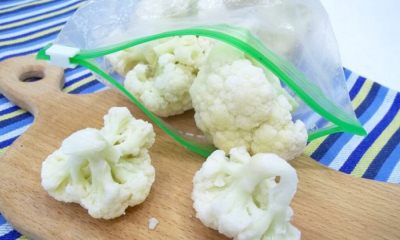 Cauliflower is a seasonal vegetable that contains many nutrients. Freezing will help to have this product on your table all year round.
Cauliflower is a seasonal vegetable that contains many nutrients. Freezing will help to have this product on your table all year round.
But for this you need to know how to freeze cauliflower for the winter (raw, boiled, together with broccoli) correctly, how and how much to store in the freezer, whether it can be thawed and re-frozen.
Content
Can I be stored in the freezer?
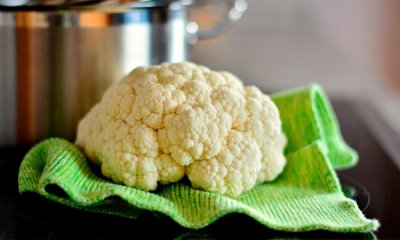 Cauliflower is a rather demanding vegetable to store. And the freezing should also be carried out according to the rules, taking into account the further use of the vegetable.
Cauliflower is a rather demanding vegetable to store. And the freezing should also be carried out according to the rules, taking into account the further use of the vegetable.
The first step to getting a quality product after thawing is choosing the right dies... The green leaves around the head of cabbage should be fresh and tight.
The inflorescences themselves are healthy, dense, without wilting areas and darkening. Black spots are associated with the appearance of the fungus. The areas affected by it are not suitable for food, and are not suitable for winter harvesting, including freezing.
Cauliflower can be frozen in different ways: fresh, boiled, disassembled into inflorescences, whole, etc. In all cases, it will retain most of the nutrients.
In this case, it is important that the following conditions are met:
- freezing should be fast enough;
- repeated defrosting and repeated freezing - prohibited;
- it is advisable to know in advance how the cabbage will be used in the future (cooking soups, stewing vegetable stews, etc.);
- the product must be fresh and of high quality initially.
When raw cabbage is frozen, the beneficial substances in it will be preserved, but the taste may change, and the consistency will not be so dense. The best option for preparing for freezing is parsing into inflorescences with a diameter of about 30 mm.
You will find all the most interesting and useful about ways to store cauliflower here.
Preparation for the process
Due to the specifics of the structure of the vegetable and the process of its cultivation, you should take a responsible attitude to the preliminary preparation of cabbage.
Highlights:
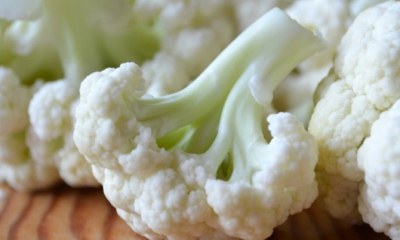 A selection of a strong, whole and dense head of cabbage.
A selection of a strong, whole and dense head of cabbage.- Pre-placing the vegetable in a container with salted water.This technique will help get rid of insects and larvae.
- Before placing it in the freezer, it is advisable to lower the vegetable in boiling water for 2 minutes, adding citric acid or fresh lemon juice.
- Immediately after boiling water, the cabbage is dipped into a container with cold water. This technique will allow not only to prevent darkening of the vegetable, but also to better preserve the beneficial substances contained in the product.
- Drying the vegetable must be thorough.
- Green leaves are removed from the head of cabbage and the inflorescences are separated. This item is not necessary, as the whole cauliflower can be frozen.
The choice of packaging: what to look for?
Choosing the right container for freezing is no less important than preparing the vegetable itself for long-term storage.
Requirements for packaging:
- compactness;
- tightness.
Ordinary cellophane bags become brittle at low temperatures and may tear. Rectangular containers are more compact than round containers.
When choosing a container, you should take into account how much vegetable you need to cook one dish... Based on this, the required container volume is determined.
The ways
Freezing cauliflower in different ways allows you to diversify your winter menu. If the vegetable is already available, it should be frozen as soon as possible, not allowing the inflorescences to be grafted.
Raw
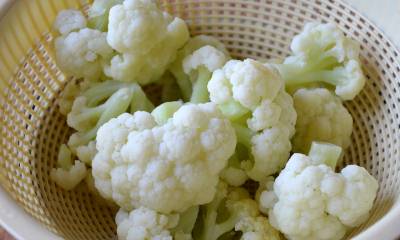 To freeze fresh vegetables, you need to prepare:
To freeze fresh vegetables, you need to prepare:
- a large enough pot for processing;
- salt;
- cabbage;
- kitchen towels;
- container;
- water.
Processing order:
- Cut off the outer leaves.
- Disassemble the head of cabbage into inflorescences. Dip the cabbage in cold salted water for 5 minutes.
- Take out the pieces.
- Spread the vegetable on napkins or kitchen towels to absorb the water.
- Place the workpiece in a prepared, clean container.
Boiled
To prepare a vegetable (0.5 kg) you will need:
- spacious saucepan;
- water (4 l.);
- salt;
- kitchen towels (napkins);
- container.
The order of work:
 Wash the vegetable.
Wash the vegetable.- Remove leaves.
- Divide the head of cabbage into approximately equal pieces. The thick main stem is not used for freezing.
- Pour water into a saucepan.
- Boil.
- Another container should contain cold water.
- After boiling water in the first saucepan, dip the cabbage into it.
- To cover with a lid.
- After boiling, add salt.
- Cook for 2-3 minutes.
- Get the inflorescences.
- Dip them in a container of cold water.
- Get it.
- Dry.
- Arrange in a prepared container.
- Send to the freezer.
During processing, the vegetable remains firm, being in the half-cooked stage.
Chopped or whole: which is better?
Cabbage can be frozen with a whole head of cabbage. In this case, after defrosting, the entire volume will need to be consumed. Freezing technology is the same. The processing feature is associated with the selection of a suitable (large enough) container.
With broccoli
Cauliflower can be frozen not only on its own, but also as part of a platter with other vegetables. One popular option is with broccoli... This set can be used in winter for cooking stews, soup and other dishes.
For cooking, you need 1 head of broccoli and 1 head of cauliflower. The weight of each of the heads is not critical.
How to prepare for freezing:
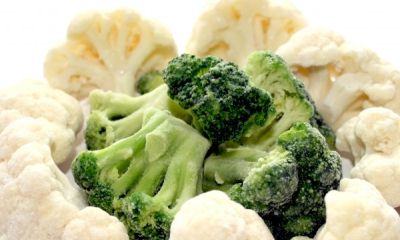 Wash the cauliflower and broccoli.
Wash the cauliflower and broccoli.- Remove the leaves.
- If there are damaged areas, they need to be cut off. The thick main stems are also removed.
- Divide both vegetables into inflorescences.
- Boil water, add salt.
- Cool down.
- Dip two types of cabbage into a container with water.
- After 15-30 minutes, take out the vegetables.
- Dry.
- Arrange in a portioned container so that both vegetables get into each container.
In addition to broccoli, green peas, chopped bell peppers, and other vegetables can be added to one bag of frozen cauliflower.
Re-freeze
For in order to rationally use a frozen vegetable, it is recommended to immediately pack it into portions... Otherwise, you will have to chop off the required amount of cabbage from a large piece or defrost all unnecessarily large amounts of product at once.
If, for some reason, more cabbage has been thawed than necessary for the preparation of one dish, the question arises whether it is possible to freeze the workpiece again. You should not do this - you need to use everything in a day.
Once thawed cabbage is no longer subject to re-freezing for the following reasons:
- loss of color, consistency, aroma and taste;
- loss of a significant part of nutrients;
- unsafe health.
Recommendations
If you adhere to the following expert advice, you can avoid many mistakes with freezing cauliflower:
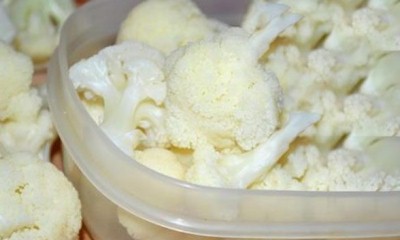 It is better to eat a thawed product within 24 hours without leaving it for a longer period.
It is better to eat a thawed product within 24 hours without leaving it for a longer period.- Cabbage, which has undergone blanching before freezing, no longer requires mandatory long-term heat treatment.
- When preparing dishes with defrosted cabbage, it must be borne in mind that the frozen vegetable cooks faster.
- Thawed cabbage can be successfully used for preparing children's and diet meals.
- When organizing long-term storage in a freezer, you need to take into account the temperature regime. At -6 ° C it is no more than a half moon, at -12 ° C - 1.5 months, at -18 ° C - until the next harvest.
- Additional labeling with the freezing date will help you navigate the shelf life of vegetables.
Using cabbage during cooking without preliminary defrosting allows you to preserve the maximum of the vegetable's nutrients.
Related Videos
How to properly freeze cauliflower, the video will tell you:
Conclusion
Frozen cauliflower can last for about a year at low temperatures. At the same time, the predominant part of nutrients remains in it.
This processing method allows you to store the vegetable for as long as possible., since, even in cellars and refrigerators, fresh cauliflower can rarely stay longer than a month.

